Bird R.B., Stewart W.E., Lightfoot E.N. Transport Phenomena
Подождите немного. Документ загружается.

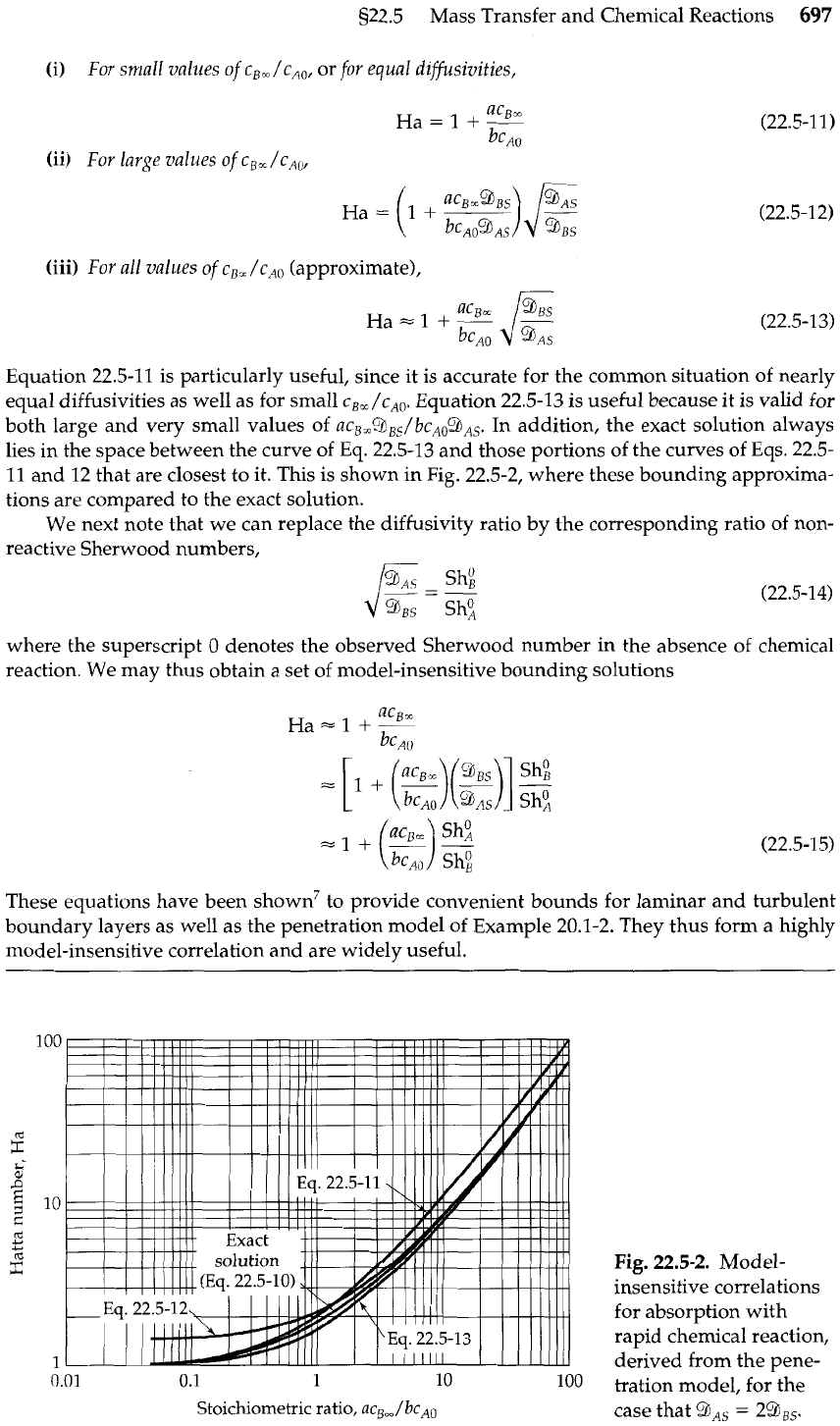
522.5 Mass Transfer and Chemical Reactions
697
(i)
For
small values
of
cB,/c,,, or
for
equal diffusivities,
acgm
Ha=1+-
~CAO
(ii)
For large
values
of
cBZ/cAO,
(iii)
For all
values
of
cB,,/cAO (approximate),
Equation 22.5-11 is particularly useful, since it is accurate for the common situation of nearly
equal diffusivities as well as for small cBm /cAO. Equation 22.5-13
is
useful because it is valid for
both large and very small values of a~,,~,~/bc~~~,,. In addition, the exact solution always
lies in the space between the curve of Eq. 22.5-13 and those portions of the curves of Eqs. 22.5-
11 and 12 that are closest to it. This is shown in Fig. 22.5-2, where these bounding approxima-
tions are compared to the exact solution.
We next note that we can replace the diffusivity ratio by the corresponding ratio of non-
reactive Sherwood numbers,
where the superscript
0
denotes the observed Sherwood number in the absence of chemical
reaction. We may thus obtain a set of model-insensitive bounding solutions
These equations have been shown7 to provide convenient bounds for laminar and turbulent
boundary layers as well as the penetration model of Example 20.1-2. They thus form a highly
model-insensitive correlation and are widely useful.
Fig.
22.5-2.
Model-
insensitive correlations
for absorption with
rapid chemical reaction,
derived from the pene-
0.01
0.1 1 10 100
tration model, foithe
Stoichiometric
ratio,
acB,/bcAo
case that
BAS
=
29IBs.

698
Chapter
22
Interphase Transport in Nonisothermal Mixtures
522.6
COMBINED HEAT AND MASS TRANSFER
BY
FREE CONVECTION
In this section we consider briefly some important interactions among the transfer
processes, with emphasis on free convection. This is an extension of our earlier discus-
sion of free-convection heat transfer in 514.6 and is reasonably well understood.
Combined heat and mass transfer by free convection is among the simple examples
of interaction between all three transport phenomena. The dimensionless equations de-
scribing them have been given in Eqs.
19.5-8
to
ll.
Numerical integration of these equa-
tions is possible,' but we can obtain simple, useful results via boundary layer theory. We
consider two particularly simple problems in the examples that follow.
Develop an expression for the combined free-convection heat and mass transfer for the spe-
cial case of equal Prandtl and Schmidt numbers. Assume that transfer is between a surface of
of Grashof
constant temperature and composition, and a large uniform surrounding fluid.
Numbers
SOLUTION
This is a direct extension of the boundary conditions of Example 11.4-5. Then if the dimen-
sionless temperature and composition are defined analogously, it follows that
?
=
5,
every-
where within the system under investigation.
It then follows that the solution of this mixed convection problem is identical to that for
heat or mass transfer alone, but with Gr or Gr, replaced by the sum (Gr
+
Gr,). This simplifi-
cation is widely used for the air-water system, where the small difference between the Sc and
Pr numbers does not have a significant effect.
Thus for evaporation from a water-wetted vertical plate (with Sc
=
0.61 and Pr
=
0.73),
one may use Eq. 11.4-11 with
C
=
0.518 to obtain
Nu,
=
0.518[0.73(Gr
+
~r,)]'/~
Sh,
=
0.518[0.61(Gr
+
~r,)]'/~
Note that the i-th powers of Pr and Sc are 0.92 and 0.88, respectively. This difference is
hardly significant in view of the uncertainties of any actual situation and the boundary layer
model on which these results are based. Note also that the thermal Grashof number is nor-
mally by far the larger, so that neglect of this interaction would greatly underestimate the
evaporation rates.
There are many situations-for example, the evaporation of solvents with low volatility-
where thermal Grashof numbers are much larger than their mass transfer counterparts (Gr
>
Free-Convecti0n
Heat
Gr,) and the Schmidt numbers exceed the Prandtl numbers (Sc
>
Pr). Under these conditions,
Transfer as a Source of
the thermal buoyant forces provide a momentum source, which in turn provides a convective
Forced-Convection
flow to drive mass transfer. It has been shown2 that the thermally induced gradient of up-
Mass Transfer
ward velocity at the surface of a vertical flat plate of length
L
is given by
Here
z
is the distance measured upward along the plate,
y
is measured outward into the fluid,
and
AT
is the difference between the plate temperature and the temperature of the surround-
ings. This is an asymptotic expression for large Prandtl number, but is also useful for gases.
Develop expressions for the local and mean Sherwood numbers.
'
W.
R.
Wilcox,
Chem.
Eng.
Sci.,
13,113-119
(1961).
A.
Acrivos,
Pkys.
Fluids,
3,657-658
(1960).
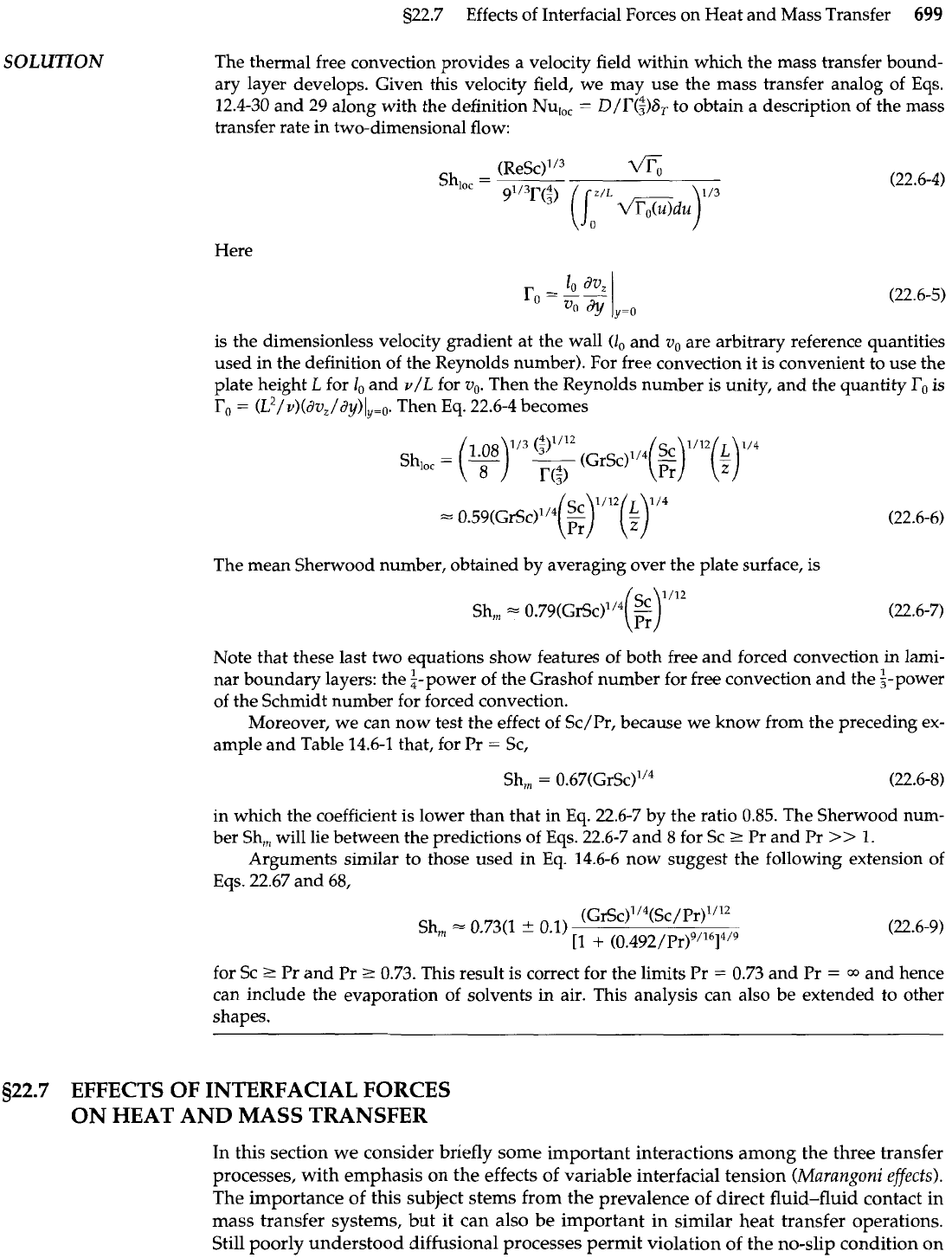
522.7 Effects of Interfacial Forces on Heat and Mass Transfer
699
SOLUTION
The thermal free convection provides a velocity field within which the mass transfer bound-
ary layer develops. Given this velocity field, we may use the mass transfer analog of Eqs.
12.4-30 and 29 along with the definition NuIoc
=
D/I'($)&
to obtain a description of the mass
transfer rate in two-dimensional flow:
Here
is the dimensionless velocity gradient at the wall
(I,
and
v,
are arbitrary reference quantities
used in the definition of the Reynolds number). For free convection it is convenient to use the
plate height
L
for
I,
and
v/L
for
v,.
Then the Reynolds number is unity, and the quantity
To
is
To
=
(L2/v)(dv,/dy)ly,,. Then Eq. 22.6-4 becomes
The mean Sherwood number, obtained by averaging over the plate surface, is
Sh,
=
0.79(GrS~)"~
-
w2
Note that these last two equations show features of both free and forced convection
in
lami-
nar boundary layers: the $-power of the Grashof number for
free
convection and the $power
of the Schmidt number for forced convection.
Moreover,
we
can now test the effect of Sc/Pr, because we know from the preceding ex-
ample and Table 14.6-1 that, for Pr
=
Sc,
Sh,
=
0.67(GrS~)'/~ (22.6-8)
in which the coefficient is lower than that in
Eq.
22.6-7 by the ratio 0.85. The Sherwood num-
ber Sh, will lie between the predictions of Eqs. 22.6-7 and 8 for Sc
r
Pr and Pr
>>
1.
Arguments similar to those used in
Eq.
14.6-6 now suggest the following extension of
Eqs. 22.67 and 68,
Sh,
=
0.73(1
+
0.1)
(G~SC)'/~(SC/P~)"'*
[l
+
(0.492/~r)~/'~]~'~
for Sc
r
Pr and Pr
1
0.73. This result is correct for the limits Pr
=
0.73 and Pr
=
and hence
can include the evaporation of solvents in air. This analysis can also be extended to other
shapes.
522.7
EFFECTS OF INTERFACIAL FORCES
ON HEAT AND MASS TRANSFER
In
this section we consider briefly some important interactions among the three transfer
processes, with emphasis on the effects of variable interfacial tension
(Marangoni
effects).
The importance of this subject stems from the prevalence of direct fluid-fluid contact in
mass transfer systems, but it can also be important in similar heat transfer operations.
Still poorly understood diffusional processes permit violation of the no-slip condition on

700
Chapter
22
Interphase Transport in Nonisothermal Mixtures
fluid flow over solid surfaces in the neighborhood of advancing menisci.' As for the dis-
torting effects of surface tension gradients on mass and heat transfer in gas-liquid con-
tacting, these will enter through a description of the boundary conditions.
According to
Eq.
llC.6-4, if the stresses in the gas (phase
11)
are ignored, the interfa-
cial tangential stresses acting on an interface with normal unit vector
n
are given bf
[(6
-
nn)
[n
711
=
-VSa
(22.7-1)
where
u
is the surface tension V9s the two-dimensional gradient operator in the inter-
face, and
(8
-
nn)
is a "projection operator" that selects those components of
[n
-
71
that
lie in the interfacial tangent plane. For example, if
n
is taken to be the unit vector in the
z
direction, Eq. 22.7-1 gives
which are the interfacial tension forces in the
x
and
y
directions acting in the xy-plane.
The surface-tension-induced stresses are typically of the same order as their hydro-
dynamic counterparts, and the flow phenomena that may result from them are known
collectively as
Marangoni
effect^.^
It
has been shown4 that mass transfer rates can be
in-
creased up to threefold by Marangoni effects, but can also be reduced in other circum-
stances.
The nature and extent of Marangoni effects depend strongly on the system geometry
and the transport properties, and it will be convenient to consider here four specific
examples:
(i)
drops and bubbles surrounded by
a
liquid continuum
(ii)
sprays of drops in a gaseous continuum
(iii)
supported liquid films in a gaseous or liquid continuum
(iv)
foams of gas bubbles in a liquid continuum
These systems, each important in practice, show very different behavior from one an-
other.
For drops and bubbles moving through a liquid continuum, the primary problems
are surfactants or microscopic particles that can reduce or eliminate the "Hadamard-
Rybczinski circulation" and also hinder the periodic mixing accompanying oscillation in
V.
Ludviksson and
E.
N.
Lightfoot,
AlCkE
Journal,
14,674-677 (1968);
P.
A.
Thompson and
S. M. Troian,
Phys.
Rev.
Letters,
63,766-769 (1997);
A.
Marmur, in
Modern Approach to Wettability: Theory
and Applications
(M.
E.
Schrader and
G.
Loeb, eds.), Plenum Press (1992);
D.
Schaeffer and P.-Z. Wong,
Phys. Rev. Letters,
80,3069-3072 (1998).
In Eq. 3.2-6 of
D.
A.
Edwards,
H.
Brenner, and
D.
T.
Wasan,
Interfacial Transport Processes and
Rheology,
Butterworth-Heinemann, Boston (1991), the operator
(8
-
nn)
is called the "dyadic surface
idemfactor"; the same quantity is called the "projection tensor" by
J.
C.
Slattery,
Interfacial Transport
Phenomena,
Springer Verlag, New York (1990),
p.
1086. Both books contain a wealth of information on
surface tension, surface viscosity, surface viscoelasticity, and other properties of interfaces and their
methods of measurement.
C.
G.
M. Marangoni,
Tipographia deifrntelli Fusi,
Pavia (1865);
Ann. Phys.
(Poggendorf), 143,337-354
(1871). Historical articles on the Marangoni effects are
L.
E.
Scriven and
C.
V.
Sternling,
Nature,
187,
186-188 (1960), and S. Ross and P. Becher,
J.
Coll. Interfac. Sci.,
149,575-579 (1992).
A
good overview of Marangoni effects and related phenomena, with emphasis on liquid-liquid
systems, is provided in
J.
C.
Godfrey and M.
J.
Slater,
Liquid-Liquid Extraction Equipment,
Wiley, New
York (1994), pp. 68-75.
A
theory offered by
C.
V.
Sternling and
L.
E.
Scriven,
AlChE Journal,
5,514-523
(1959), provides useful insight but is considered too simple to give reliable predictions of the onset of
instabilities.
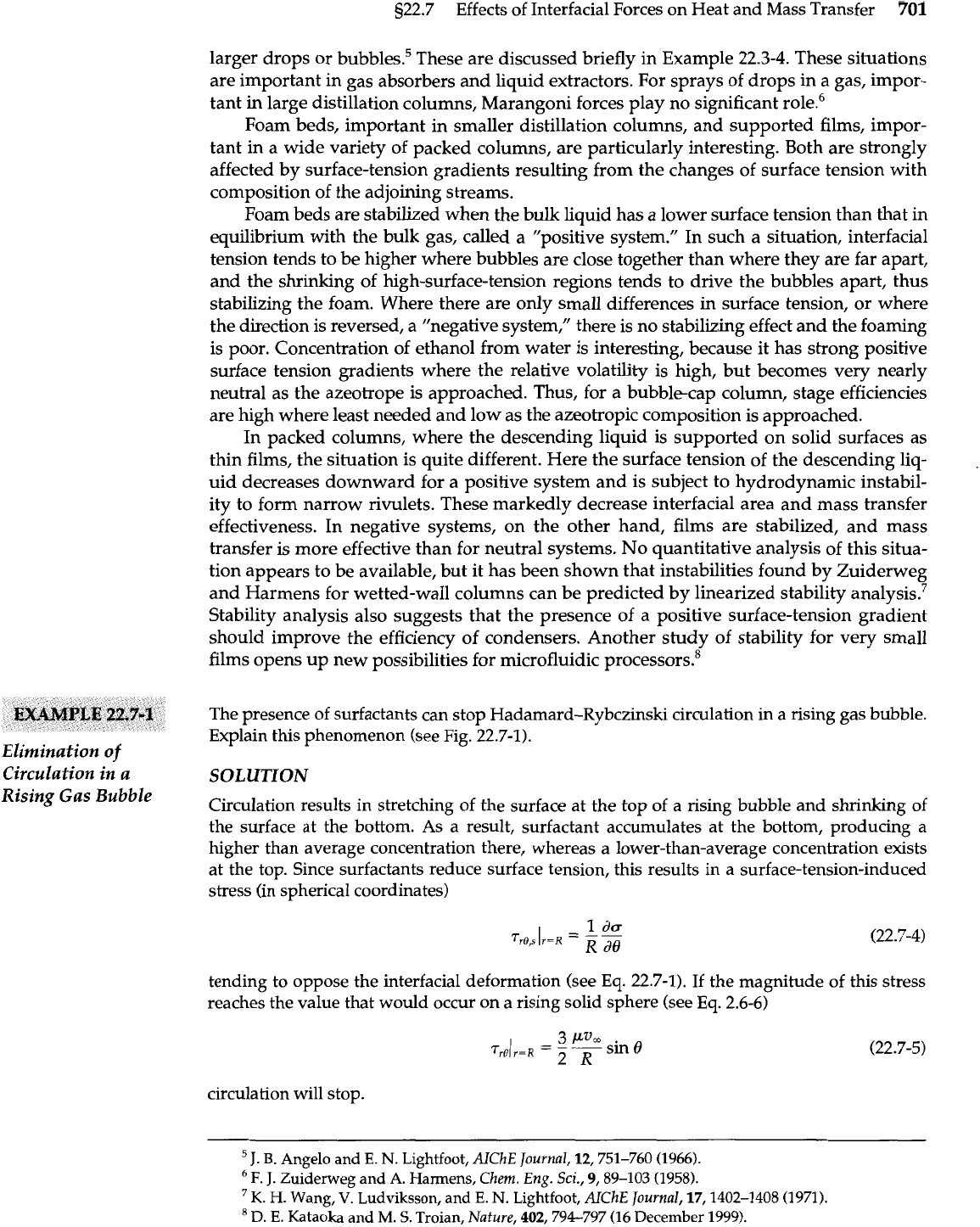
s22.7 Effects of Interfacial Forces on Heat and Mass Transfer
701
larger drops or
bubble^.^
These are discussed briefly in Example 22.3-4. These situations
are important in gas absorbers and liquid extractors. For sprays of drops in a gas, impor-
tant
in
large distillation columns, Marangoni forces play no significant role.6
Foam beds, important in smaller distillation columns, and supported films, impor-
tant in a wide variety of packed columns, are particularly interesting. Both are strongly
affected by surface-tension gradients resulting from the changes of surface tension with
composition of the adjoining streams.
Foam beds are stabilized when the buik liquid has a lower surface tension than that in
equilibrium with the bulk gas, called a "positive system." In such a situation, interfacial
tension tends to be higher where bubbles are close together than where they are far apart,
and the shrinking of high-surface-tension regions tends to drive the bubbles apart, thus
stabilizing the foam. Where there are only small differences in surface tension, or where
the direction is reversed, a "negative system," there is no stabilizing effect and the foaming
is poor. Concentration of ethanol from water is interesting, because it has strong positive
surface tension gradients where the relative volatility is high, but becomes very nearly
neutral as the azeotrope is approached. Thus, for a bubble-cap column, stage efficiencies
are high where least needed and low as the azeotropic composition is approached.
In packed columns, where the descending liquid is supported on solid surfaces as
thin films, the situation is quite different. Here the surface tension of the descending liq-
,
uid decreases downward for a positive system and is subject to hydrodynamic instabil-
ity to form narrow rivulets. These markedly decrease interfacial area and mass transfer
effectiveness. In negative systems, on the other hand, films are stabilized, and mass
transfer is more effective than for neutral systems. No quantitative analysis of this situa-
tion appears to be available, but it has been shown that instabilities found by Zuiderweg
and Harmens for wetted-wall columns can be predicted by linearized stability analy~is.~
Stability analysis also suggests that the presence of a positive surface-tension gradient
should improve the efficiency of condensers. Another study of stability for very small
films opens up new possibilities for microfluidic processors.8
EXAMPLE
22.7-1
Elimination of
The presence
of
surfactants can stop Hadamard-Rybczinski circulation in a rising gas bubble.
Explain this phenomenon (see Fig. 22.7-1).
Circulation in a
SOLUTION
Rising
Gas
Circulation results in stretching of the surface at the top of
a
rising bubble and shrinking of
the surface at the bottom. As
a
result, surfactant accumulates at the bottom, producing a
higher than average concentration there, whereas a lower-than-average concentration exists
at the top. Since surfactants reduce surface tension, this results in a surface-tension-induced
stress (in spherical coordinates)
tending to oppose the interfacial deformation (see
Eq.
22.7-1). If the magnitude of this stress
reaches the value that would occur on a rising solid sphere (see
Eq.
2.6-6)
-
3
w'm
rrol
r=R
-
7
sin
0
circulation will stop.
J.
B.
Angelo and
E.
N.
Lightfoot,
AICkE Journal,
12,751-760 (1966).
F.
J.
Zuiderweg and A. Harmens,
Chem. Eng.
Sci.,
9,89-103 (1958).
K.
H.
Wang,
V.
Ludviksson, and
E.
N.
Lightfoot,
AIChE Journal,
17,1402-1408 (1971).
D.
E.
Kataoka and
M.
S.
Troian,
Nature,
402,794-797 (16
December
1999).

702
Chapter 22 Interphase Transport in Nonisothermal Mixtures
Surfactant
adsorption
Surfactant
release
Fig.
22.7-.1
Surfactant transport during Hadamard-
Rybuynski circulation
As a practical matter, even small amounts of surfactant prevent circulation. Small con-
centration of microscopic suspended particulates have a similar effect, being swept to the rear
of bubbles and forming a rigid surface.
Among the simplest mass-transfer-induced Marangoni effects is instability
in
a falling film re-
sulting from counterflow adsorption of vapors with a high heat of solution. An important
Marangoni Instability
representative example is the counterflow absorption of
HCI
vapor into water, which is so in-
in a Falling Film
efficient that cocurrent flow is preferable. Explain this effect.
S
0
L
UTION
This situation can be simulated by allowing a film of water to flow down a plate that is colder
at the top than at the bottom. If sufficient care is taken, one can obtain a sinusoidally varying
film thickness, as shown9 by interferometry in Fig. 22.7-2(a). Here each new dark line repre-
sents a line of constant thickness, differing from its neighbors by one-half wavelength of light
in the water.
This situation corresponds to a series of parallel
roll
cells
of the type pictured in Fig. 22.7-
2(b),
driven by lateral surface tension gradients. These gradients, in turn, result from small
variations in film thickness caused by inevitable small spatial variations of surface velocity:
the thicker regions move faster and thus tend to be colder than the thin regions. A simple per-
turbation analysis1 shows that perturbations of some widths grow faster than others, and the
fastest growing ones tend to dominate. The periods of the sinusoidal lines in Fig. 22.7-2(a)
correspond to these fastest growing disturbances.
Such regularity is, however, seldom observed in practice. More commonly one sees occa-
sional thick rivulets surrounded by large thin regions. These thin regions, taking up most of
the available surface, are both slowly moving and quickly saturated and are thus ineffective
for mass transfer. Only the rivulets are effective, and their total surface area is very small.
Similar behavior is observed for surface-tension gradients caused by vertical variations in
composition. However, in that case the behavior is more complicated and requires an analy-
sis of interphase mass tran~fer.~

522.8 Transfer Coefficients at High Net Mass Transfer Rates
703
Fig.
22.7-2.
(a) Initiation of Marangoni instability
in a draining liquid fluid film.
(b)
Fully developed
Marangoni instability.
(c)
Qualitative picture of
vertical roll-cell disturbances
[V.
Ludviksson and
E.
N.
Lightfoot,
AIChE
Journal, 14,620-626 (1968)l.
522.8
TRANSFER COEFFICIENTS AT
HIGH
NET MASS TRANSFER RATES
High net mass transfer rates across phase boundaries distort the boundary-layer profiles
of velocity and temperature as well as species concentration, and they also alter the
boundary layer thicknesses. Both of these effects tend to increase friction factors and the
heat and mass transfer coefficients, if the mass transfer is toward the boundary, and to
reduce them in the reverse situation. These usual trends are reversed, however, in free
convection and in flows driven by a rotating surface. The magnitudes of such changes
are dependent on the system geometry, boundary conditions, and the magnitudes of the
governing parameters such as the Reynolds, Prandtl, and Schmidt numbers, and they
are accompanied by the effects of changes in physical properties. They can also either in-
crease or decrease the hydrodynamic stability. Accurate allowance for the effects of net
mass transfer thus requires extensive calculation and/or experimentation, but some of
the more salient features can be illustrated by using idealized physical models, and this
is the approach we follow here.
We begin with the classic stagnant-film model, which provides simple estimates of the
profile distortion, but is incapable of predicting changes in the effective film thickness.
We then discuss the perzetratiorz model and the flat-plate laminar boundary layer model. We
conclude with several illustrative examples, the last of which is a complete numerical ex-
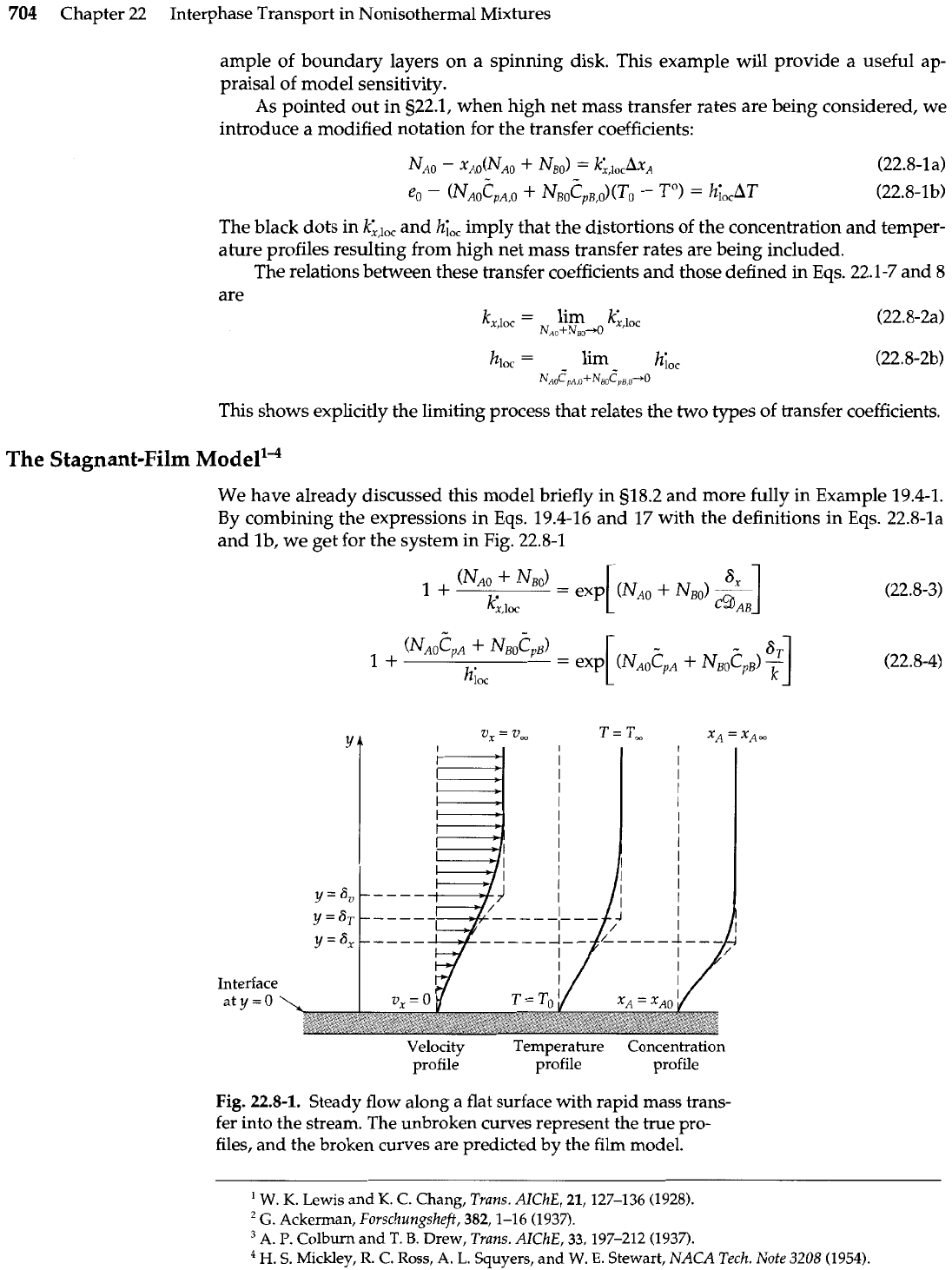
704
Chapter
22
Interphase Transport in Nonisothermal Mixtures
ample of boundary layers on
a
spinning disk. This example will provide a useful ap-
praisal of model sensitivity.
As pointed out in 922.1, when high net mass transfer rates are being considered, we
introduce a modified notation for the transfer coefficients:
The black dots in
k;,,,,
and
hioc
imply that the distortions of the concentration and temper-
ature profiles resulting from high net mass transfer rates are being included.
The relations between these transfer coefficients and those defined in Eqs. 22.1-7 and 8
are
=
lim
&,,oc
4'10c
NAo+NB,,-+O
(22.8-2a)
This shows explicitly the limiting process that relates the two types of transfer coefficients.
The
Stagnant-Film
We
have already discussed this model briefly in 518.2 and more fully in Example 19.4-1.
By
combining the expressions in Eqs. 19.4-16 and 17 with the definitions in Eqs. 22.8-la
and lb, we get for the system in Fig. 22.8-1
Interface
Velocity Temperature Concentration
profile profile profile
Fig.
22.8-1.
Steady flow along a flat surface with rapid mass trans-
fer into the stream. The unbroken curves represent the true pro-
files, and the broken curves are predicted by the film model.
'
W.
K.
Lewis
and
K.
C. Chang,
Trans.
AIChE,
21,127-136 (1928).
'
G.
Ackerman,
Forschungsheft,
382,l-16 (1937).
A.
P.
Colburn and
T.
B.
Drew,
Trans.
AIChE,
33,197-212 (1937).
H.
S.
Mickley, R. C. Ross,
A.
L.
Squyers, and
W.
E.
Stewart,
NACA
Tech. Note
3208
(1954).

s22.8 Transfer Coefficients at High Net Mass Transfer Rates
705
By following the limiting processes indicated in Eqs. 22.8-2a and 2b, we then get expres-
sions for the transfer coefficients in the low net mass transfer limit:
These limiting values are found by expanding the right sides of Eqs. 22.8-3 and 4 in Tay-
lor series and retaining two terms. Substitution of Eqs. 22.7-5 and 6 into Eqs. 19.4-16 and
17
enables us to eliminate the film thicknesses (which are ill-defined) in favor of the
transfer coefficients at low mass-transfer rates (which are measurable):
These equations are the principal results of the film model. They show how the conduc-
tive energy flux and the diffusion flux at the wall depend on
NAo
and
NBo.
In this model,
the effects of net mass transfer on the conductive and diffusive interfacial fluxes are
clearly analogous. Although these relations were derived for laminar flow and constant
physical properties, they are also useful for turbulent flow and for variable physical
properties (see Problem 22B.3).
The results for heat and mass transfer can be summarized in two equations:
Equation 22.8-9 gives the correction factors
6,
and
OT
by which the coefficients
kX,,,,
and
bloc
must be multiplied to obtain the coefficients at high net mass transfer rates. Equation
22.8-10 gives the concentration and temperature profiles. The meanings of the symbols
are summarized in Table 22.8-1.
Table
22.8-1
Summary of Dimensionless Quantities to be Used for
All
Models Discussed in 522.8. Mass-based versions appear in 520.2 and
s22.9.
--
0
=
correction factors
R
=
flux ratios
4
=
rate factors
II
=
profiles
7
=
dimensionless distance from wall
Mass transfer Heat transfer
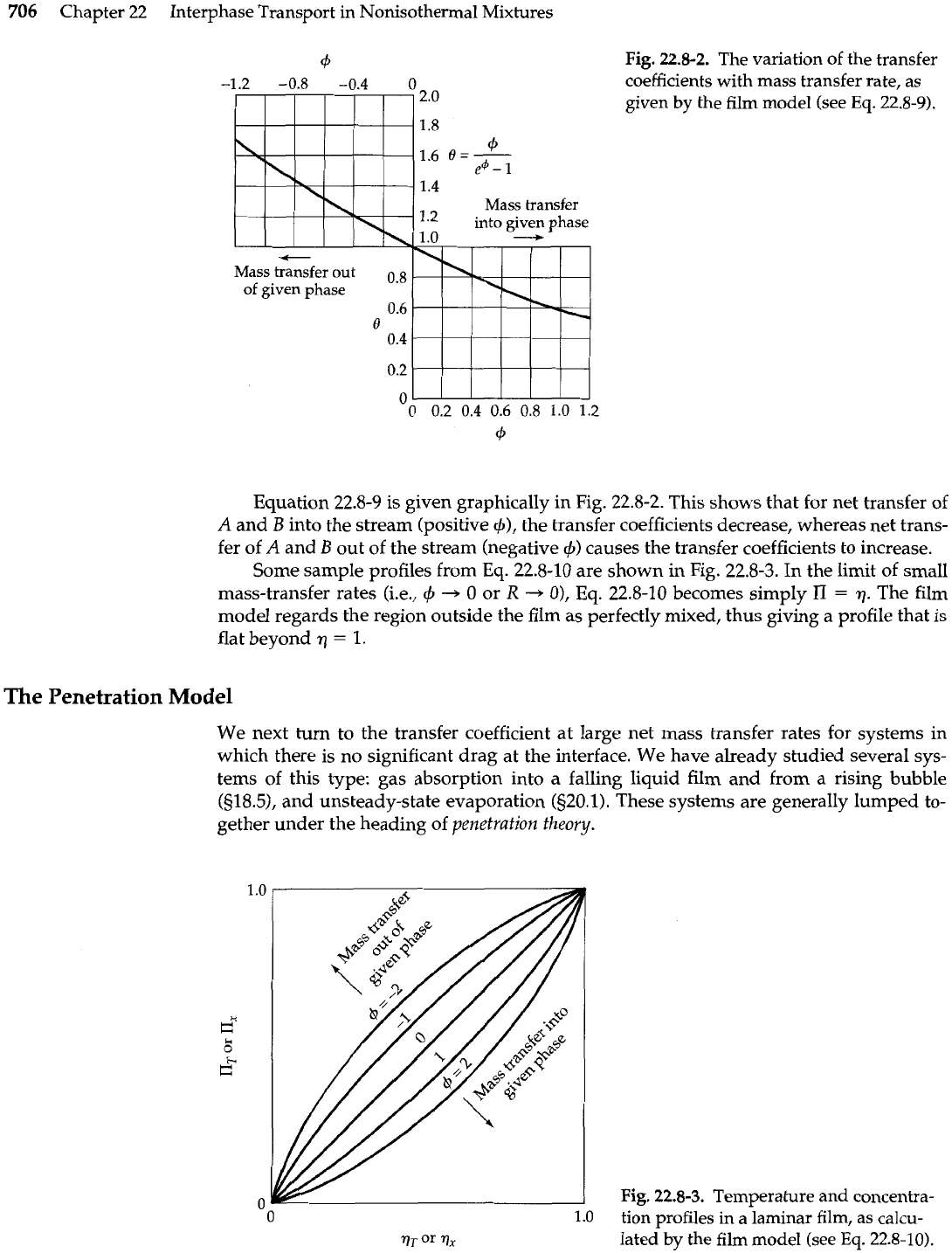
706
Chapter
22
Interphase Transport in Nonisothermal Mixtures
Fig.
22.8-2.
The variation of the transfer
coefficients with mass transfer rate, as
given
by
the
film
model (see
Eq.
22.8-9).
Equation 22.8-9 is given graphically in Fig. 22.8-2. This shows that for net transfer of
A
and
B
into the stream (positive
+),
the transfer coefficients decrease, whereas net trans-
fer of
A
and
B
out of the stream (negative
4)
causes the transfer coefficients to increase.
Some sample profiles from
Eq.
22.8-10 are shown in Fig. 22.8-3. In the limit of small
mass-transfer rates (i.e.,
4
+
0
or
R
+
O),
Eq.
22.8-10 becomes simply
IT
=
q.
The film
model regards the region outside the film as perfectly mixed, thus giving a profile that is
flat beyond
q
=
1.
The Penetration Model
We next turn to the transfer coefficient at large net mass transfer rates for systems in
which there is no significant drag at the interface. We have already studied several sys-
tems of this type: gas absorption into a falling liquid film and from a rising bubble
(§18.5), and unsteady-state evaporation (520.1). These systems are generally lumped to-
gether under the heading of
penetration theory.
Fig.
22.8-3.
Temperature and concentra-
1.0
tion profiles in a laminar film, as
calcu-
lated
by
the film model (see
Eq.
22.8-10).
